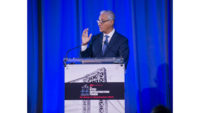Dream Projects: Nicaragua Canal Faces Huge Costs

A canal across Nicaragua would shave 500 miles off the shipping route between New York and Los Angeles.
The idea of an interoceanic waterway through Nicaragua is far older than the existing, 100-year-old Panama Canal. For centuries, Spanish conquistadors, modern-day diplomats and others have floated proposals to build a route through Nicaragua—even early U.S. proponents of a Central American canal project originally favored Nicaragua over Panama.
 |
The transit time to ship goods across Nicaragua would be longer than that of Panama, but the overall voyage would provide savings. That’s because the route would shave more than 500 miles off a trip from New York City to Los Angeles, a fact not lost on global shippers—including Maersk Line, one of the world’s biggest—that are supporting a Chinese company’s $50-billion proposal to build the canal.
"Building a Nicaragua Canal seems to make good sense,” Keith Svendsen, vice president of the Danish transportation company told industry website ShippingWatch.com earlier this year. What’s more, Panama cannot yet handle the world’s largest ocean vessels, even with its current third-lane expansion, he noted. Russia President Vladimir Putin has also publicly expressed support of the route.
Backed by Hong Kong-based developer HKND Group, proponents envision digging and dredging a 173-mile route that stretches from the Pacific side, at Brito, to the Caribbean Sea. The route would extend more than three times longer than the Panama Canal, but much of it would cover inland waterways, such as Lake Nicaragua, which would require dredging to accommodate such large vessels as container ships and oil tankers.
The developer, which last year was granted a concession to build and operate the canal for up to 100 years, has pledged support of the project without government funds from Beijing. Chinese entrepreneur Wang Jing, the firm’s chairman, has also promised to back the canal project with economic rather than geopolitical or military interests in mind.
“I know you don’t believe me,” Wang told Reuters this past May. “You believe there are people from the Chinese government in the background providing support. Why, in the end, is only Wang Jing out front?”
Project partners currently include feasibility consultant China Railway Construction Corp. and lead designer China Railway Siyuan Survey and Design Group. Other early-phase project participants include McKinsey & Co. and Environmental Resources Management Ltd.
According to HKND, the project will require excavating some 5 billion cubic yards of earth and rock, which it expects to start this December and complete in five years. Chinese manufacturer XCMG has been retained to provide equipment exclusively for that effort, while project officials have been consulting with Australian mining companies to map out methods to chew away at the land’s complex topography.
Construction and engineering experts agree that the risks are huge for a project whose cost estimate exceeds Nicaragua’s own gross domestic product by more than a factor of four.
“Like any megaproject, they exaggerate the benefits and underestimate the costs,” says Jean-Paul Rodrigue, a professor at Hofstra University who studies global transportation issues. “It might break ground, but at some point in time I think it is going to financially collapse.” This month, people in Nicaragua’s have been protesting the project, fearing loss of land, environmental disaster and other concerns.








